ASUS P5N32-E SLI Plus: NVIDIA's 650i goes Dual x16
by Gary Key on April 2, 2007 3:30 AM EST- Posted in
- Motherboards
Standard Gaming Performance
As usual, gaming performance was tested with a variety of current games. We ran benchmarks with our standard 1280x1024 resolution without antialiasing enabled (and generally without anisotropic filtering, though that varies by game). Given the number of users that run 19" LCDs these days, 1280x1024 represents one of the most commonly used resolutions. We could certainly increase the amount of eye candy being displayed in most of the games, but as this is a motherboard benchmark we aren't particularly interested in maxing out the graphics cards in our tests.
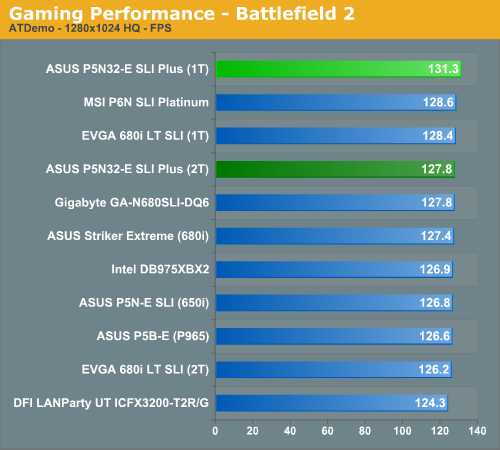
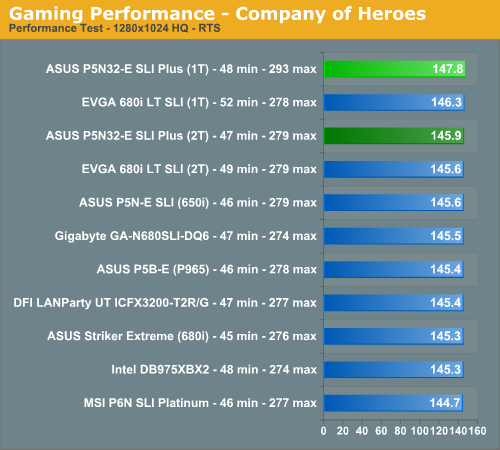
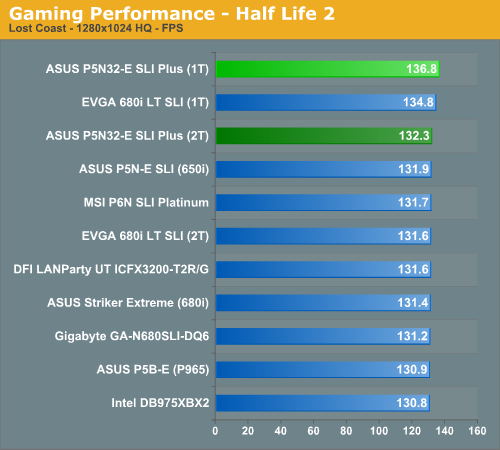
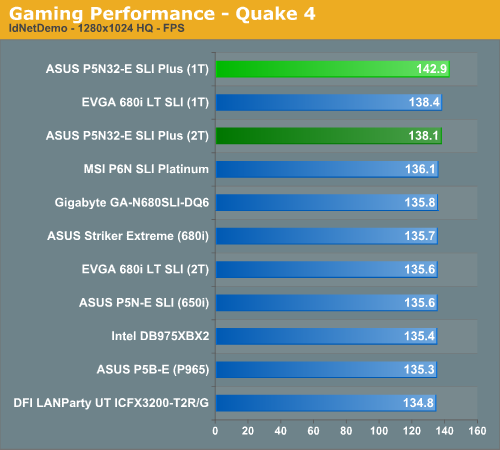
We still think it is basically a toss up as to which chipset you select for a gaming machine. All of the results are very close and during actual game play we could not tell any real differences between the boards. However, ASUS told us this board was optimized for game play and all indications from our test results agree with them. While the differences in overall scores are minimal to a degree, our subjective opinion after playing with the ASUS board for several weeks is that it's just a bit "snappier" than our other boards when it comes to game play. Our EVGA board also scored very well with 1T enabled but still could not keep pace with the ASUS board due to its extremely aggressive sub-timings.
We did not experience any issues during testing or during game play with the ASUS board at stock settings with our memory choice. We did encounter some issues with our budget memory modules due to the very tight memory sub-timings but once we relaxed tRC, tRFC, and tRRD timings the board was very stable. We generally play over a dozen different games for at least a couple of hours on each board to ensure there are no issues such as overheating, stuttering, or network issues when playing online with a various combination of components.
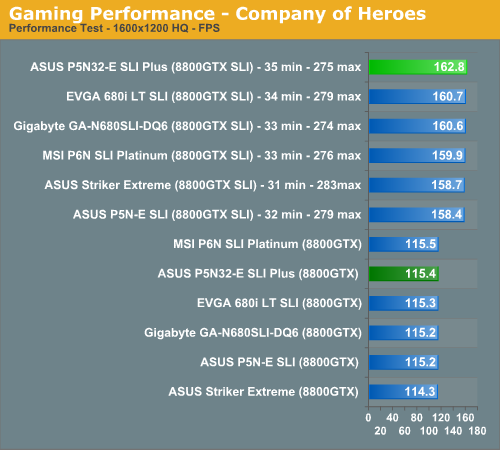
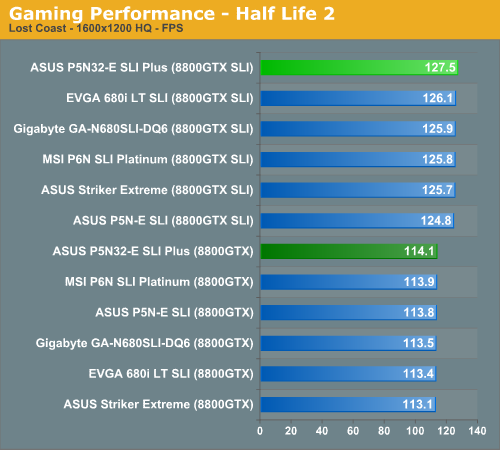
In our limited SLI testing, we once again find our ASUS P5N32-E SLI Plus taking top honors in our test results due to superior memory performance. We still have not seen any noticeable differences in 8800GTX SLI performance between the 680i, 650i hybrid, and 650i chipsets up to 1920x1200 resolutions in games. Any test result differences can be attributed to the performance of the board/BIOS itself and not the PCI Express design. It is only when you crank up the resolution to 2560x1600 or increase AA/AF settings that the dual x16 PCI Express capability on the 680i performs better than the dual x8 PCI Express setup on 650i setups. We will have additional game and resolution results in our roundup article.
As usual, gaming performance was tested with a variety of current games. We ran benchmarks with our standard 1280x1024 resolution without antialiasing enabled (and generally without anisotropic filtering, though that varies by game). Given the number of users that run 19" LCDs these days, 1280x1024 represents one of the most commonly used resolutions. We could certainly increase the amount of eye candy being displayed in most of the games, but as this is a motherboard benchmark we aren't particularly interested in maxing out the graphics cards in our tests.




We still think it is basically a toss up as to which chipset you select for a gaming machine. All of the results are very close and during actual game play we could not tell any real differences between the boards. However, ASUS told us this board was optimized for game play and all indications from our test results agree with them. While the differences in overall scores are minimal to a degree, our subjective opinion after playing with the ASUS board for several weeks is that it's just a bit "snappier" than our other boards when it comes to game play. Our EVGA board also scored very well with 1T enabled but still could not keep pace with the ASUS board due to its extremely aggressive sub-timings.
We did not experience any issues during testing or during game play with the ASUS board at stock settings with our memory choice. We did encounter some issues with our budget memory modules due to the very tight memory sub-timings but once we relaxed tRC, tRFC, and tRRD timings the board was very stable. We generally play over a dozen different games for at least a couple of hours on each board to ensure there are no issues such as overheating, stuttering, or network issues when playing online with a various combination of components.


In our limited SLI testing, we once again find our ASUS P5N32-E SLI Plus taking top honors in our test results due to superior memory performance. We still have not seen any noticeable differences in 8800GTX SLI performance between the 680i, 650i hybrid, and 650i chipsets up to 1920x1200 resolutions in games. Any test result differences can be attributed to the performance of the board/BIOS itself and not the PCI Express design. It is only when you crank up the resolution to 2560x1600 or increase AA/AF settings that the dual x16 PCI Express capability on the 680i performs better than the dual x8 PCI Express setup on 650i setups. We will have additional game and resolution results in our roundup article.










37 Comments
View All Comments
yacoub - Sunday, April 29, 2007 - link
Just curious about the audio CPU usage test usually done on boards...Leinad - Tuesday, April 3, 2007 - link
In the FAQ for this board on the Asus website, the board is listed as a 680i board. Newegg lists it as a 650i board, and Anandtech likewise calls it a 650i board. Nice to finally see an explanation.Looking forward to the Motherboard roundup!
goinginstyle - Thursday, April 5, 2007 - link
Any chance of testing some cheap memory?sWORDs - Tuesday, April 3, 2007 - link
I'm really disappointed by this review, it's not up to the usual Anandtrch quality. Let me explain why:You can not call this a 650, because there is no nForce 430 southbridge.
Calling the southbridge a AMD570 is a bit misleading, because NB 570AMD = NB 590AMD = SB 590AMD = SB 590i = SB 680i.
Further more there might not even be a difference in the northbridge even if it has 8 lanes disabled, those aren't connected with the "real" 680i's either. They appear as a hidden link, the links on the Hybrid also have a missing #1 port, so it's there, not sure if it's cut or disabled. The only bord that appears to use it isn't here yet, it's the MSI Diamond with 4 PEG ports.
Besides this, you failed to notice that the pcb is actually a Striker Extreme (just peak under de Plus sticker). So any difference between this bord and a Striker Extreme are caused by difference of Bios, or between individual bords. You can't compare one Striker and one Plus and One Evga and make chipset conclussions, two Strikers might end up on different FSB speeds.
"680i SLI chipset utilizes the nForce 590 SLI MCP and 680i SLI MCP." That should be 680i SPP.
Memory timing differences should be caused by bios difference. THe Striker has a 1004 bios ready did you use that?
Dainas - Tuesday, April 3, 2007 - link
Great, so theirs only one PCI slot(rendered useless if you SLI) and the only PCIe 1x is rendered useless if you put a decent videocard in this machine.Not that any friggin SLI/Crossfire LGA board on the market can be considered much better should you want to have more than a soundcard installed.
sWORDs - Tuesday, April 3, 2007 - link
It has two PCI slots and only one would useless when using SLI with double sized cards. The only PCIe 1x is useless when using a double sized card.yacoub - Tuesday, April 3, 2007 - link
Btw this board gets some horrid reviews over on NewEgg. Sure, the user reviews there are known to be pretty tough because anytime someone has a bad experience they're ten times more likely to write about it than someone who has a good experience. But still, compare the reviews of this board with the reviews of the MSI board Anandtech reviewed last week.I wouldn't consider buying this Asus board seeing how many DOAs and other problems folks are reporting with it. The MSI, which doesn't overclock as well, seems much more likely to at least be a 100% functioning product.
How sad that the motherboard market has become this unreliable. I remember when Asus was a board you'd pay just a little more for because it would be solid.
kilkennycat - Monday, April 2, 2007 - link
.. 0501 has an extensive list of 23 fixes over 0402 !!The current latest is 0602 BETA.
See the Asus website. Make sure that you search for the PLUS version of the P5N32E-SLI.
Tuffrabbit - Monday, April 2, 2007 - link
It is interesting that the "budget" 650i board draws a whopping 47 more watts at idle than even the Flagship D975 Intel board ???Tuffrabbit - Monday, April 2, 2007 - link
Correction: Make that 57 watts...